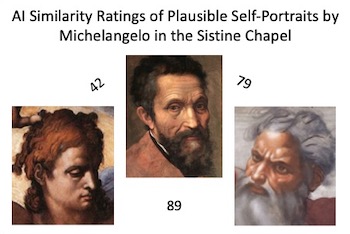
Three of the faces in Michelangelos Sistine Chapel frescos are recognized as portraits: his own sardonic self-portrait in the flayed skin held by St Bartholomew, itself a portrait of the scathing satirist Pietro Agostino, and the depiction of Mary as a portrait of his spiritual soulmate Vittoria Colonna. The first analysis was of the faces of the depictions of God and of the patriarch Jacob, which were rated by AI-based facial ratings as highly similar to each other and to a portrait of Michelangelo. A second set of young faces: Jesus, Adam and Sebastian, were also rated as highly similar to God and to each other. These ratings suggest that Michelangelo depicted himself as all these central figures in the Sistine Chapel frescoes. Similar ratings of several young women across the ceiling suggested that they were further portraits of Vittoria Colonna, and that she had posed for Michelangelo as a model for the Sistine Chapel personages in her younger years.

This paper explores the use of existing methods found in image science literature to perform 'first-pass' specification and modeling of imaging systems intended for use in autonomous vehicles. The use of the Johnson Criteria [1] and suggestions for its adaptation to modern systems comprising neural nets or other machine vision techniques is discussed to enable initial selection of field of view, pixel size and sensor format. More sophisticated Modulation Transfer Function (MTF) modeling is detailed to estimate the frequency response of the system, including lower bounds due to phase effects between the sampling grid and scene [2]. A signal model is then presented accounting for illumination spectra, geometry and light level, scene reflectance, lens geometry and transmission, and sensor quantum efficiency to yield electrons per lux second per pixel in the plane of the sensor. A basic noise model is outlined and an information theory based approach to camera ranking presented. Thoughts on progressing the above to look at color differences between objects are mentioned. The results from the models are used in examples to demonstrate preliminary ranking of differently specified systems in various imaging conditions.